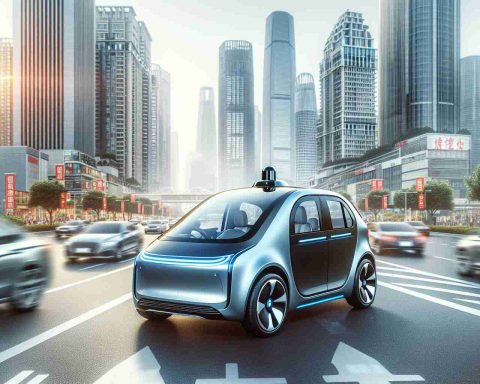- Tesla’s Full Self-Driving (FSD) technology is caught in the crossfire of a US-China trade war.
- Chinese authorities have delayed FSD approval, using it as leverage in trade negotiations.
- China remains a critical market for Tesla, with strong sales despite global declines.
- Elon Musk aims to launch Tesla’s autonomous vehicles in China by 2025 but faces regulatory and geopolitical obstacles.
- Local competitor BYD is ready to capture market share with its own technology offerings.
- The situation exemplifies the complex interplay between technology and geopolitics in the modern economy.
- Tesla must navigate these geopolitical challenges to maintain its technological and economic standing.
Tesla finds itself entwined in a complex geopolitical chess match as it navigates the choppy waters of international business. Its sought-after Full Self-Driving (FSD) technology hangs in the balance, caught between the competing interests of two superpowers locked in a trade war.
The sleek Tesla sedans, with their promise of autonomous driving, wait in limbo as Chinese authorities deliberate over granting approval to Tesla’s FSD system. But this is no ordinary delay. This decision has evolved into a powerful bargaining chip in the escalating trade disputes with the United States. Sources indicate that China’s decision-makers astutely recognize the leverage this provides in the ongoing negotiations.
For Tesla, China represents not only a lucrative market but a lifeline. It is the only place where its sales figures remain robust amid a global decline, making the FSD approval all the more crucial. However, the Chinese government, aware of its strategic position, holds the reins tightly.
Elon Musk, Tesla’s charismatic CEO, faces an uphill battle. He dreams of unleashing Tesla’s autonomous fleet in China by 2025. Yet, he candidly admits that the regulatory maze and geopolitical impasses greatly complicate these ambitions. Meanwhile, local rival BYD circles closely, poised to snatch market share with its own advanced offerings.
As China deftly maneuvers this approval as a negotiation tool, the stakes soar. This scenario highlights a modern economic reality where technology and global politics are inexorably entwined, challenging companies like Tesla to adapt—or face potentially dire consequences. In this high-stakes game, the balance of technological dominance and economic influence teeters precariously.
Tesla’s Geopolitical Quagmire: The Future of Full Self-Driving Technology in China
How-To Steps & Life Hacks: Navigating International Business Regulations
For businesses like Tesla entering complex international markets, it’s crucial to:
1. Understand Local Laws: Stay informed about regulatory requirements of each market. For Tesla, understanding China’s safety and technology standards for autonomous vehicles is critical.
2. Engage with Local Authorities: Build relationships with regulatory bodies to streamline approval processes. Regular dialogues can provide clarity and reduce unexpected delays.
3. Adapt Products to Local Needs: Tailor your offerings to meet local cultural and economic conditions. Tesla might consider engineering adjustments to better fit Chinese consumers.
4. Stay Updated on Geopolitical Developments: Monitor trade relations and political climates, as they can directly impact business operations.
5. Diversify Risk: Avoid overreliance on a single market to reduce vulnerability. For instance, expanding into Europe or Southeast Asia could mitigate potential downturns from Chinese market issues.
Real-World Use Cases: Full Self-Driving (FSD) Benefits
Tesla’s FSD technology offers several benefits:
– Safety Enhancements: Reduces human error, the leading cause of accidents (National Highway Traffic Safety Administration).
– Increased Mobility: Provides transportation independence for non-drivers, the elderly, and disabled individuals.
– Efficiency: Optimized driving can reduce traffic congestion and lower emissions.
– Cost Savings: Potential to lower insurance costs and vehicle damage.
Market Forecasts & Industry Trends
The autonomous vehicle industry is expected to explode, with some estimates projecting a market size of $556.67 billion by 2026 (Allied Market Research). China, as the largest automotive market, is a significant growth area for autonomous vehicles. Tightening regulations and a push towards cleaner energy vehicles are shaping these market trends.
Controversies & Limitations: The FSD Dilemma
While Tesla’s self-driving technology presents numerous opportunities, challenges include:
– Safety Concerns: Ongoing debates on the safety of FSD systems, exacerbated by occasional crashes.
– Regulatory Hurdles: Differing international standards and slow regulatory approvals impede widespread adoption.
– Data Privacy: Concerns about the handling of data collected by vehicles, particularly in countries with strict data protection laws.
Reviews & Comparisons: Tesla vs. Competitors
– Tesla vs. BYD: While Tesla leads in innovation, BYD’s local market presence and understanding of Chinese consumers present tough competition.
– Price Point: Tesla’s models tend to be premium priced compared to local alternatives.
– Technical Superiority: Tesla’s software prowess sets it apart, yet BYD and other local brands focus on affordability and meeting specific regulatory standards.
Security & Sustainability
Tesla must ensure cybersecurity for its vehicles, given the data captured by FSD systems. Environmentally, Tesla’s electric vehicles contribute positively by reducing reliance on fossil fuels, aligning with global efforts toward sustainability.
Insights & Predictions: The Future of Tesla in China
Experts predict that while Tesla faces significant challenges, its innovative edge and adaptability can eventually lead to success in the Chinese market. However, diversification and strategic partnerships might be necessary to mitigate risks.
Actionable Recommendations and Quick Tips
1. Enhance Diplomacy: Strengthen ties with Chinese authorities through transparent communications and joint ventures.
2. Increase R&D: Focus on product development that aligns with local market demands and regulatory expectations.
3. Leverage Global Networks: Collaborate with global partners to advocate for universal autonomous driving standards, easing global deployment.
For those interested in keeping up with Tesla and similar advancements, Tesla and National Highway Traffic Safety Administration are primary sources for reliable information.
These steps and insights empower businesses and consumers to navigate the evolving landscape of autonomous technology effectively.

















